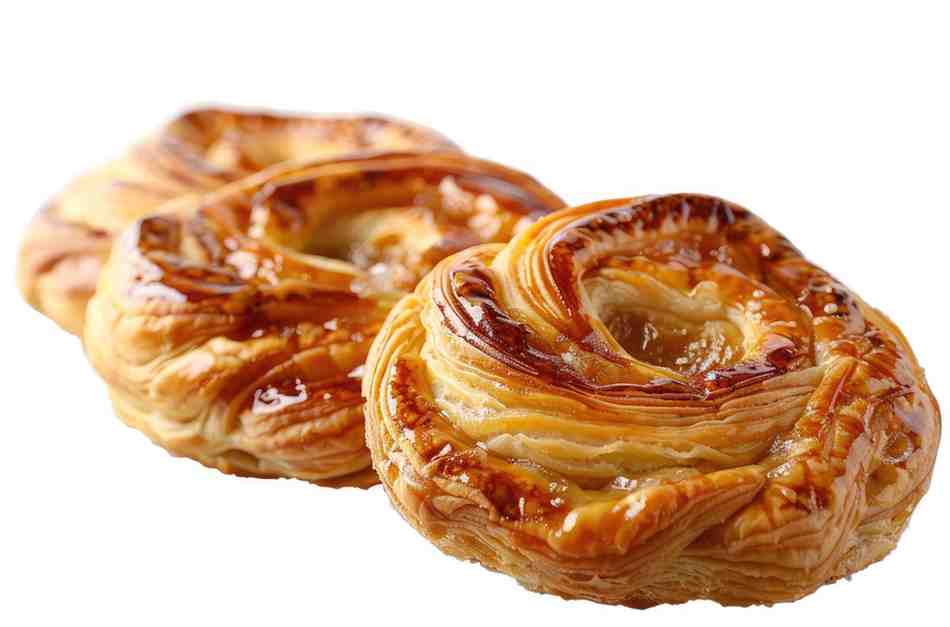Wienerbrød, commonly known as “Danish pastry” outside Denmark, is a rich, flaky, and buttery delight. Originating in Denmark, it has captivated pastry lovers for centuries. This pastry is crafted with layers of buttery dough filled with jams, custards, or chocolate, often topped with pearl sugar or icing. Wienerbrød holds a special place in Danish culinary culture and showcases the art of Danish baking.
The History of Wienerbrød
The Origin of Danish Pastry
Wienerbrød originated in Denmark during the 19th century but was influenced by Austrian bakers. In the 1850s, Danish bakers went on strike, and Austrian bakers were brought in to fill the gap. These bakers introduced the method of laminating dough with butter, a technique they used for making their own pastries. Danish bakers quickly adopted this method, giving rise to what we now know as Wienerbrød.
How Vienna Shaped Danish Baking Tradition
Although the term “Wienerbrød” means “Viennese bread,” Danish bakers made key modifications. They used their local ingredients and refined the technique to create a lighter and flakier texture. The Danish version soon became more popular than the original Austrian pastry, especially because of its variety of fillings and unique preparation style.
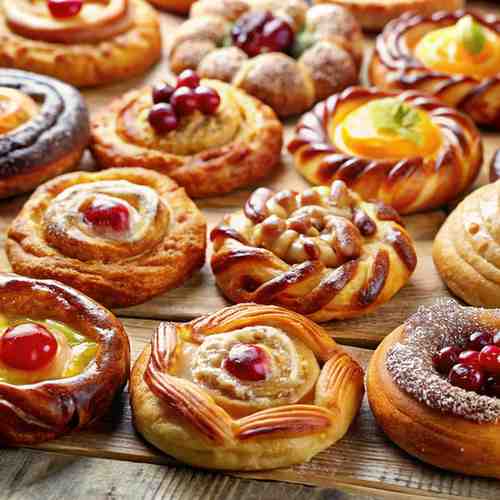
Wienerbrød’s Journey to Global Popularity
Wienerbrød’s fame did not remain confined to Denmark. Danish immigrants who moved to the United States and Europe brought their treasured recipes with them. By the early 20th century, these pastries were a staple in bakeries, particularly in the U.S. In American bakeries, the pastries evolved into larger, sweeter versions, often filled with cream cheese or fruit, but the essence of the traditional Danish pastry remained intact.
Traditional Methods of Making Wienerbrød
The unique, flaky layers of Wienerbrød come from a technique called “lamination,” where butter is repeatedly folded into the dough to create thin, light layers. This technique demands precision and patience, but the result is well worth the effort.
Preparing the Classic Dough
To make the dough for Wienerbrød, you start with simple ingredients: flour, butter, yeast, sugar, eggs, and milk. First, you mix the yeast into the dough, which helps the pastry rise during baking. Afterward, a large amount of cold butter is folded into the dough to create alternating layers.
Key Ingredients for Wienerbrød
High-quality ingredients are essential for making authentic Wienerbrød. These are the must-haves:
- Flour: All-purpose flour provides the structure needed for the dough.
- Unsalted Butter: Danish butter, with its higher fat content, creates a richer, flakier pastry.
- Yeast: Active dry yeast or fresh yeast gives the dough a light, airy texture.
- Milk: Full-fat milk enhances the richness of the dough.
- Sugar: A little sugar adds sweetness and helps the dough brown.
- Eggs: Eggs contribute to the softness and tenderness of the pastry.
Each ingredient plays a crucial role in achieving the perfect texture and flavor of the pastry.
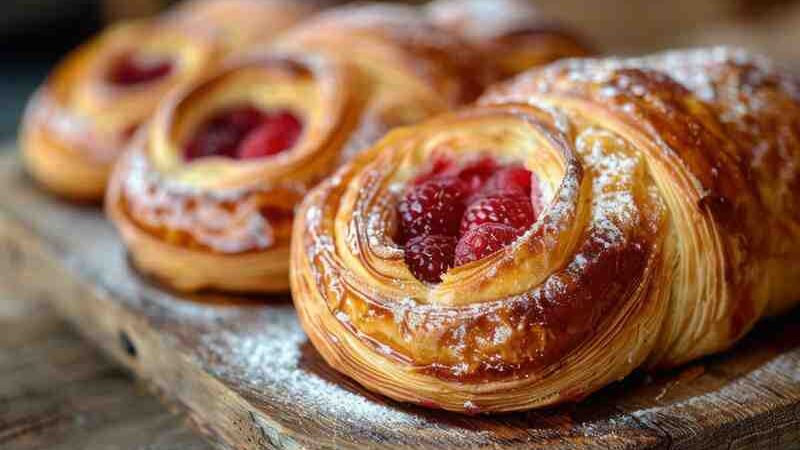
Mastering the Rolling and Folding Technique
The lamination process is key to creating the signature flaky texture of Wienerbrød. Here’s how it works:
- Roll the Dough: Start by rolling the dough into a large rectangle.
- Layer with Butter: Place thin slices of cold butter across the dough.
- Fold: Fold the dough into thirds, much like folding a letter.
- Repeat: Continue rolling and folding several times to create multiple layers.
This process creates layers of dough and butter that puff up when baked, resulting in a crisp, flaky pastry. As you repeat the folds, the dough becomes lighter, while the butter stays trapped between the layers, which contributes to the flaky texture.
Different Shapes and Styles of Wienerbrød
Wienerbrød stands out for its versatility, offering a wide range of shapes and fillings. Danish bakers are known for their creativity, transforming this laminated dough into various visually appealing pastries.
Popular Shapes of Wienerbrød
- The Braid: This classic shape involves spreading the filling down the center of the dough, cutting slanted strips along the sides, and folding them over the filling in a criss-cross pattern to form a braid.
- The Spiral: Similar to a cinnamon roll, this version features rolled dough filled with fruit or custard and topped with icing.
- The Pocket: By folding dough squares over the filling, you create a neat pocket, keeping the filling enclosed while baking.
- The Diamond: In this shape, bakers fold the dough into a diamond with the filling exposed in the center.
Common Fillings in Wienerbrød
The fillings used in Wienerbrød can vary widely, providing plenty of opportunities for creativity. Some popular fillings include:
- Fruit Preserves: Raspberry, apricot, and strawberry preserves are classic choices that add sweetness and a hint of tartness.
- Custard: A rich vanilla custard provides a creamy contrast to the flaky pastry layers.
- Almond Paste: Sweet, nutty almond paste is a favorite in many traditional Danish pastries.
- Chocolate: For an indulgent twist, melted dark chocolate or chocolate chips are perfect.
Garnishes and Toppings
Once baked, Wienerbrød often receives special garnishes to elevate its flavor and appearance. Popular toppings include:
- Pearl Sugar: Adds a sweet, crunchy texture on top of the pastry.
- Sliced Almonds: Almonds enhance the pastry’s buttery, nutty flavor.
- Icing: A drizzle of icing made from powdered sugar and milk completes the look and taste of the pastry.
The Global Popularity of Wienerbrød
Though it originated in Denmark, Wienerbrød has made its mark around the world. Particularly in the United States, “Danishes” have become breakfast staples. American versions of Danish pastries tend to be larger and sweeter than their Danish counterparts, but they retain the same delicious, flaky texture.
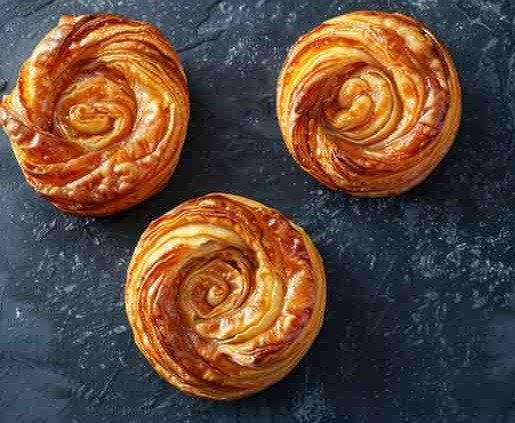
- American Adaptations: In the U.S., bakeries often fill Danish pastries with cream cheese, blueberries, or apple cinnamon. These fillings cater to American preferences but still highlight the rich dough and buttery layers of the original Wienerbrød.
- In Europe: Other European countries have also adopted Danish pastries, each adding their local twists. Yet, the signature flaky dough and fillings remain central to the pastry’s appeal.
Recipe, Variations, and Cultural Significance of Wienerbrød
Wienerbrød, a beloved Danish pastry, is as much a work of art as it is a culinary delight. While mastering this pastry demands patience, the end result is more than worth the effort. Not only does Wienerbrød offer a flaky, buttery texture, but it also comes in many delicious variations that cater to all tastes. Beyond the kitchen, this pastry holds a special place in Danish culture. In this section, we’ll cover how to make it, modern takes on the classic, and the cultural importance of this sweet treat.
The Ultimate Wienerbrød Recipe
Creating Wienerbrød at home may seem daunting, but with the right approach and ingredients, it’s entirely achievable. This step-by-step guide will walk you through the process to ensure your homemade Danish pastries turn out perfectly.
Ingredients
To make this classic Danish pastry, you’ll need the following:
- 3 ½ cups all-purpose flour
- 1 ½ cups cold unsalted butter, sliced
- 4 ½ teaspoons active dry yeast
- ½ cup warm water (100-110°F)
- ½ cup heavy cream
- 2 large eggs, at room temperature
- ¼ cup sugar
- ½ teaspoon salt
- ½ teaspoon cardamom
- Your choice of filling (e.g., raspberry jam, custard, almond paste)
Step-by-Step Instructions
- Mix the Dough
Start by dissolving the yeast in warm water, letting it sit for about 10 minutes. In another bowl, mix the flour and salt. Next, add the cold butter slices into the flour mixture. Using a pastry cutter or food processor, blend the butter and flour until the butter pieces are about the size of peas. - Combine Wet Ingredients
In a separate bowl, whisk the eggs, sugar, cream, and cardamom together. Once the yeast mixture is ready, add it to the wet ingredients and stir to combine. - Form the Dough
Gradually fold the flour-butter mixture into the wet ingredients. Stir until the dough comes together, but be careful not to overmix. You want to see small chunks of butter in the dough, as these will create the flaky layers during baking. - Chill and Fold the Dough
Cover the dough and refrigerate for at least 4 hours or overnight. After chilling, roll the dough out on a floured surface into a large rectangle. Fold the dough into thirds, turn it, and roll it out again. Repeat this process three times to create layers of butter within the dough. - Shape and Fill the Pastries
Divide the dough in half and roll each piece into a rectangle. Add your chosen filling down the center. For a braided pastry, cut slanted strips on the sides and fold them over the filling in a criss-cross pattern. - Bake the Pastries
Preheat the oven to 400°F. Allow the shaped pastries to rise for 20-30 minutes. Brush with an egg wash, sprinkle with pearl sugar or sliced almonds, and bake for 12-15 minutes until golden brown. - Finish with Icing
While the pastries cool, mix powdered sugar with a small amount of milk to create icing. Drizzle the icing over the pastries for an extra touch of sweetness.
Tips for Perfect Wienerbrød
- Keep the Dough Cold: Chilling the dough is key to ensuring the butter doesn’t melt during the folding process, which helps create the signature flaky layers.
- Don’t Overmix: Be gentle when mixing the dough to avoid breaking down the butter layers, which are crucial for the texture.
- Use High-Quality Butter: Danish or European-style butter, which has a higher fat content, works best for this recipe, adding richness to the pastry.
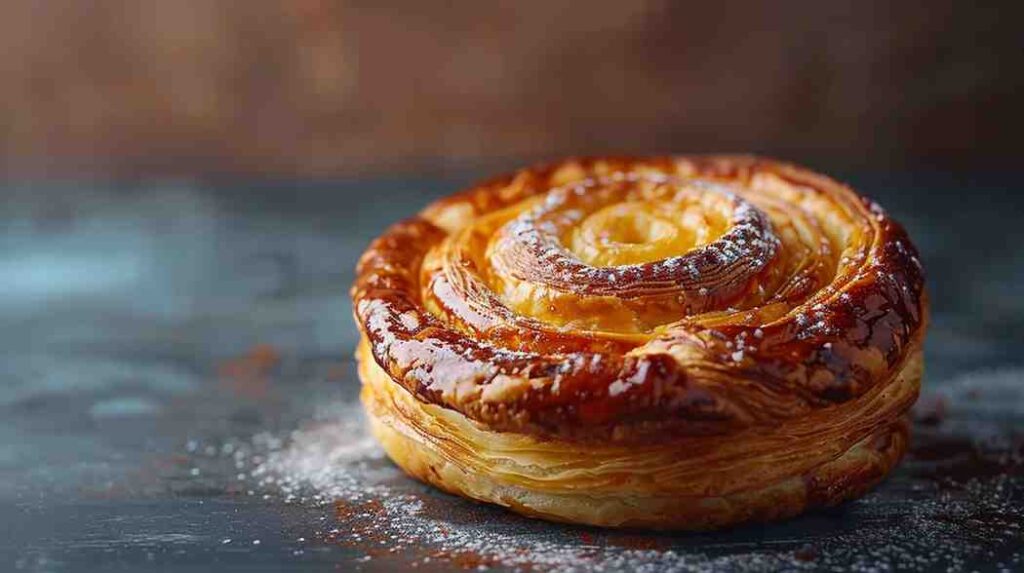
Modern Variations of Wienerbrød
While traditional Wienerbrød remains a favorite, modern variations have emerged to cater to different dietary preferences and flavor profiles. Bakers around the world have adapted the recipe to suit contemporary tastes while maintaining the classic lamination technique.
American Danish Pastries
In the United States, Danish pastries have become a breakfast staple. These versions often feature larger sizes and sweeter fillings, including cream cheese, blueberry, or apple cinnamon. Although they are richer and denser than the Danish originals, they preserve the essence of Wienerbrød’s buttery, flaky layers.
Health-Conscious Alternatives
For those who want a lighter version, bakers have developed ways to modify the traditional recipe without sacrificing its flaky goodness.
- Whole-Wheat Wienerbrød: Replace some of the all-purpose flour with whole-wheat flour for a nuttier, fiber-rich alternative.
- Gluten-Free Wienerbrød: By using gluten-free flour blends, you can create a gluten-free version of the pastry that still delivers great texture.
- Vegan Variations: Use plant-based butter and non-dairy milk to make a vegan-friendly version of Wienerbrød. Many fillings, such as fruit jams and almond paste, are already naturally vegan.
Flavor Innovations
Innovative bakers have also experimented with new flavor combinations, pushing the boundaries of traditional Wienerbrød.
- Chocolate-Hazelnut Danish: Swap fruit fillings for Nutella or another chocolate spread to add a rich, decadent twist.
- Spiced Danish Pastries: Cinnamon or cardamom can be mixed into the dough or sprinkled on top to create a warm, spiced flavor that’s perfect for fall.
- Savory Versions: Some bakers have experimented with savory fillings like cheese, spinach, or mushrooms, offering a more versatile take on Wienerbrød.
Cultural Significance of Wienerbrød in Denmark
Wienerbrød is more than just a delicious pastry; it is also a vital part of Danish culture. Danish bakeries are revered for their craftsmanship, and the tradition of serving Wienerbrød reflects the values of hospitality and celebration.
The Importance of Bakeries in Denmark
Bakeries are integral to Danish daily life. Many Danes visit local bakeries each morning for fresh pastries, bread, and coffee. Wienerbrød is a popular choice for these morning rituals, and its presence in bakeries highlights the Danish focus on quality and tradition. Beyond being a breakfast item, Wienerbrød is also an essential part of Danish coffee tables during family gatherings, holidays, and special occasions.
Wienerbrød in Danish Celebrations
Wienerbrød plays a significant role in Danish celebrations, from birthdays to holidays like Christmas. During these special times, families often gather for “kaffebord,” where an assortment of cakes and pastries, including Wienerbrød, is served alongside coffee. This tradition underscores the role of pastries in fostering a sense of togetherness and celebration in Danish culture.
Frequently Asked Questions About Wienerbrød
What makes Wienerbrød different from other Danish pastries?
Wienerbrød refers specifically to pastries made using laminated dough with butter folded into it. Other types of Danish pastries might use different doughs or methods but share a similar flaky texture.
Can you freeze Wienerbrød dough?
Yes, you can freeze Wienerbrød dough. Once you’ve completed the folding process, wrap the dough tightly in plastic and place it in a freezer-safe bag. When ready to use, thaw the dough overnight in the fridge and continue with shaping and baking.
How long does it take to make Wienerbrød?
The entire process, including chilling the dough, takes between 6 to 8 hours. Most of this time involves letting the dough rest in the fridge to ensure proper lamination and rising.
What are the best fillings for Wienerbrød?
Popular fillings include fruit preserves (such as raspberry or apricot), vanilla custard, almond paste, and chocolate. However, you can experiment with different flavors to suit your taste.
How can I make Wienerbrød healthier?
Consider using whole-wheat flour for added fiber or opting for reduced-sugar fillings. You can also explore vegan or gluten-free variations by using alternative ingredients that maintain the pastry’s texture and flavor.

